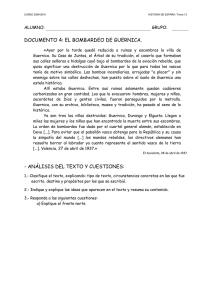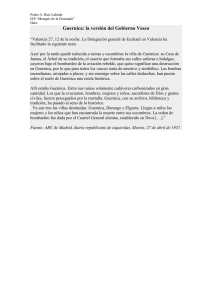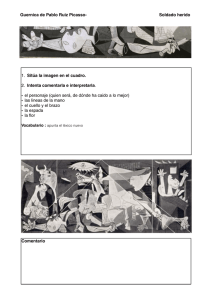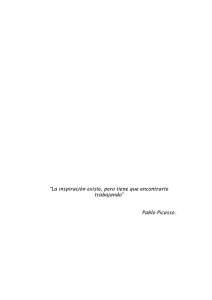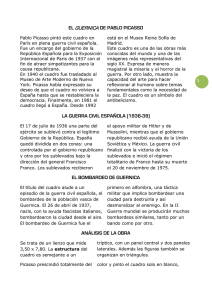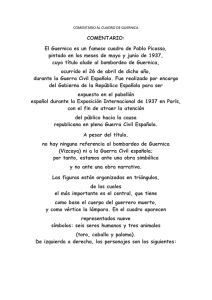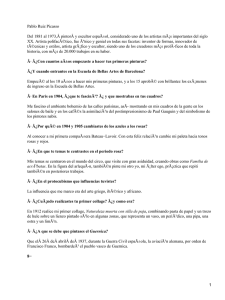Guernica: el bombardeo Actividades
Anuncio
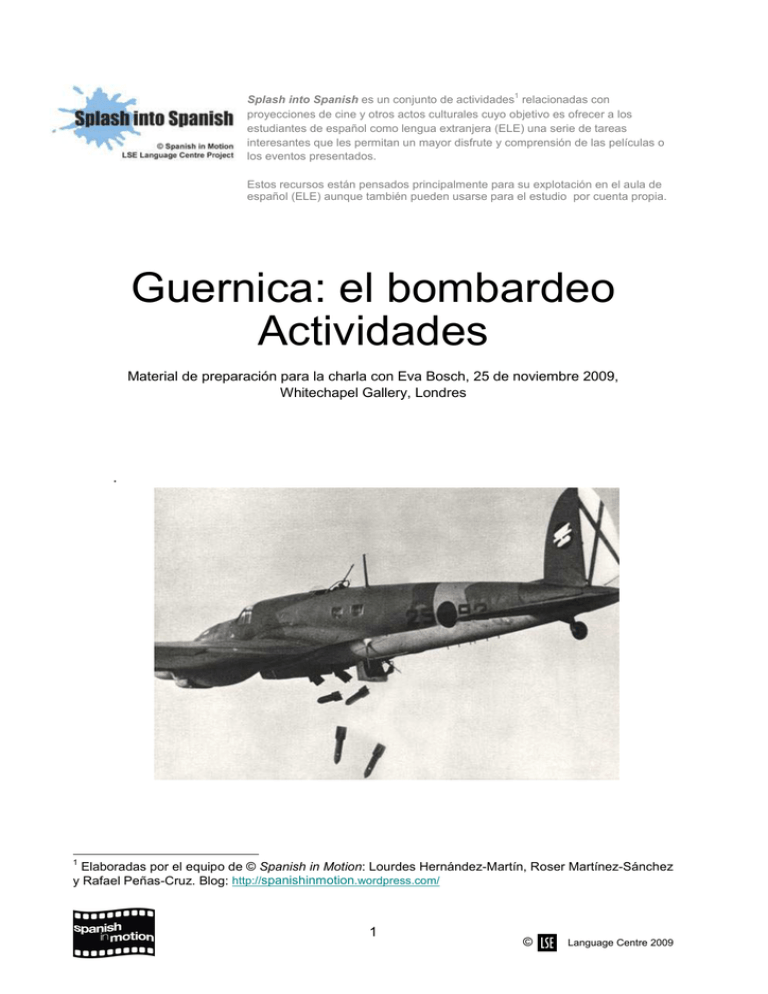
Splash into Spanish es un conjunto de actividades1 relacionadas con proyecciones de cine y otros actos culturales cuyo objetivo es ofrecer a los estudiantes de español como lengua extranjera (ELE) una serie de tareas interesantes que les permitan un mayor disfrute y comprensión de las películas o los eventos presentados. Estos recursos están pensados principalmente para su explotación en el aula de español (ELE) aunque también pueden usarse para el estudio por cuenta propia. Guernica: el bombardeo Actividades Material de preparación para la charla con Eva Bosch, 25 de noviembre 2009, Whitechapel Gallery, Londres . 1 Elaboradas por el equipo de © Spanish in Motion: Lourdes Hernández-Martín, Roser Martínez-Sánchez y Rafael Peñas-Cruz. Blog: http://spanishinmotion.wordpress.com/ 1 © Language Centre 2009 El Guernica en Whitechapel En enero de 1939, una galería del deprimido East End londinense exhibía una pintura impactante sobre los horrores de la guerra, la angustia y el sufrimiento humano, firmada por Pablo Picasso. Aquel cuadro, el Guernica, acabaría convirtiéndose en la más famosa declaración antibélica del arte moderno. A lo largo de tan sólo dos semanas, miles de personas desfilaron por la Whitechapel Gallery para contemplarlo, en un gesto de solidaridad con la bombardeada población vasca (1937) y de apoyo a las fuerzas republicanas frente al acoso franquista. Setenta años después, la obra acaba de regresar al mismo lugar, aunque cobra la forma de un tapiz encargado en su día por el propio artista malagueño. La pieza, realizada por un estudio de tejedores franceses en los años cincuenta, preside la instalación de la polaca Goshka Macuga (finalista del premio Turner), consagrada a la relación entre arte y propaganda. Un homenaje a aquella exhibición de la pintura original del Guernica en Reino Unido que, en plena Guerra Civil española, se erigió en toda una declaración política contra el avance de los fascistas. Clement Attlee, a la sazón líder laborista y futuro primer ministro, inauguraba la muestra flanqueado por miembros de las Brigadas Internacionales. La presencia del Guernica en el Londres de 1939 fue el único alto en su camino desde el estudio parisino de Picasso hacia Estados Unidos, donde permanecería en custodia hasta la llegada de la democracia a España, por deseo expreso de su autor. El Guernica regresa a Londres http://www.elpais.com/articulo/cultura/Guernica/regresa/Londres/elpepicul/20090401elpepicul_2/Tes 2 © Language Centre 2009 PÁGINAS WEB Páginas web generales sobre la Guerra Civil o o o Portal sobre la Guerra Civil Española http://www.historiasiglo20.org/enlaces/gceindexen.htm El cine y la Guerra civil española http://www.ucm.es/info/multidoc/multidoc/revista/num9/cine/guerra-civil/principal.html Guernica: 70 años después http://news.bbc.co.uk/hi/spanish/specials/2007/guernica/default.stm Páginas relacionadas CORRESPONSALES DE GUERRA EN LA GUERRA CIVIL ESPAÑOLA: George Steer y otros o o o Exposición “Corresponsales de guerra en la Guerra Civil española” organizada por el Instituto Cervantes: http://cvc.cervantes.es/actcult/corresponsales/ Crónicas de los Corresponsales de guerra en la Guerra Civil española con sus traducciones http://cvc.cervantes.es/actcult/corresponsales/cronicas/indice.htm Vídeo-entrevista con el Pr. Paul Preston http://www2.lse.ac.uk/language/Projects/SpanishProjects/SplashintoSpanish/Splashinto Spanish.aspx FOTOGRAFOS EN LA GUERRA CIVIL ESPAÑOLA o o o Fotoperiodismo en la Guerra Civil Española (en inglés) http://orpheus.ucsd.edu/speccoll/swphotojournalism/index.html Gerda Taro http://mujeresriot.webcindario.com/Gerda_Taro.htm Robert Capa en la agencia fotográfica Magnum (en inglés) http://www.magnumphotos.com/Archive/C.aspx?VP=XSpecific_MAG.PhotographerDeta il_VPage&l1=0&pid=2K7O3R14YQNW&nm=Robert%20Capa 3 © Language Centre 2009 ACTIVIDAD 1.VOCABULARIO. Vocabulario 1 (Varios niveles) Une las palabras de la izquierda con las definiciones o lo sinónimos de la otra columna. 1. Levantamiento/ sublevación a. En las relaciones internacionales, dirigir temporalmente algunos asuntos interiores de otra nación. b. Conjunto de voluntarios armados no pertenecientes al ejército regular. c. Soldados extranjeros alistados con el ejército republicano. d. Que defiende la libertad absoluta y, por lo tanto, la supresión de todo gobierno y de toda ley. e. Dicho de una nación o de un Estado: Que no toma parte en la guerra movida por otros y se acoge al sistema de obligaciones y derechos inherentes a tal actitud. f. Partidarios del lado leal en la guerra Civil española. g. Partidarios del lado rebelde en la Guerra Civil española h. Doctrina que propugna la desaparición del Estado y de todo poder i. Rebelión j. Cambio violento en las instituciones políticas, económicas o sociales de una nación 2. Revolución 3. (Los) Nacionales 4. (Los) Republicanos 5. Anarquista 6. Libertario 7. Brigada internacional 8. Neutralidad/No beligerancia 9. Intervención 10. Milicia 1. …… 2. …… 3. …… 4. …… 5. …… 6. …… 7. …… 8. …… 9. …… 10. …… 4 © Language Centre 2009 ACTIVIDAD 2. EN CONTEXTO (Varios niveles) En grupos, poned en común lo que sabéis sobre la Guerra Civil española? 1.-¿Cuándo tuvo lugar? 2.-¿Quiénes participaron? 3.-¿Cuáles fueron las causas? 4.-¿Qué actitud tuvieron las potencias extranjeras? 5.-¿Quién ganó la guerra y qué factores determinaron la victoria? 6.-¿Qué consecuencias tuvo la derrota? ACTIVIDAD 3. COMPRENSIÓN ESCRITA Lectura 1 (B1-C1). El bombardeo de Guernica: ni el primero, ni el último. El bombardeo de Guernica (Operación Rügen) fue un ataque aéreo realizado sobre esta población vasca el 26 de abril de 1937, en el transcurso de la Guerra Civil Española, por parte de la Legión Cóndor alemana y la Aviación Legionaria italiana, que combatían en favor de los sublevados (o nacionales). Tres cuartas partes de los edificios fueron destruidos y las estimaciones actuales de víctimas cifran los fallecidos en un rango que abarca de los 120 a los 300 muertos. En 1907, temiendo ya este tipo de ataques, la Convención de la Haya, instrumento esencial del derecho humanitario internacional, recoge en su artículo 25 que “Es prohibido atacar o bombardear, cualquiera que sea el medio que se emplee, ciudades, aldeas, habitaciones o edificios que no estén defendidos”. Esta prohibición, sin embargo, ha sido violada en numerosas ocasiones. 5 © Language Centre 2009 Al contrario de lo que se piensa, el bombardeo de Guernica no fue el primer bombardeo de la historia sobre población civil. Los italianos habían empezado en el año 1911 cuando bombardearon Tagiura en Libia. Después serían los españoles que, en 1913, atacaron un pueblo en el norte del Marruecos “español” como castigo por su rebeldía. El bombardeo aéreo se convertiría desde estos acontecimientos en una práctica frecuente de las guerras coloniales. Guernica tampoco fue el primer bombardeo sobre una población en la Guerra Civil española. Un mes antes, en marzo, aviones italianos habían bombardeado Durango durante 20 minutos, causando unos 180 muertos. Ni Durango ni Guernica fueron tampoco los primeros lugares en los que la población civil fue atacada durante la Guerra Civil: en febrero de 1937, la misma Legión Cóndor había ametrallado una columna de refugiados civiles en la carretera entre Málaga y Almería causando cientos de víctimas. Sin embargo, es cierto que el bombardeo de Guernica fue el primer bombardeo en alfombra con el objetivo de destruir una ciudad. El bombardeo de Guernica fue además un ataque contra lo que se considera el alma del pueblo vasco: Guernica ha sido históricamente la cuna de la autonomía vasca. Los sublevados, buscando una justificación para el ataque, atribuyeron la destrucción de la ciudad a los propios republicanos diciendo que la habían quemado las “hordas rojas”. Más tarde justificarían el bombardeo arguyendo que se trataba de destruir un puente por el que pasaban los refuerzos republicanos. La realidad de los hechos se reveló pronto al mundo debido a la presencia en Bilbao de varios periodistas ingleses de importancia como George Steer (The Times) y la repercusión internacional del bombardeo no se hizo esperar, convirtiéndose este episodio en uno de los símbolos más conocidos del horror de la guerra y el sufrimiento de civiles en conflictos armados. En 1997, el entonces presidente de Alemania, Roman Herzog, en carta leída a los supervivientes del bombardeo por el embajador alemán en España con motivo del 60 aniversario, pidió públicamente perdón por la manifiesta autoría alemana del bombardeo. . Di si las siguientes afirmaciones son verdaderas o falsas según el texto y justifica aquellas que consideres falsas: 1.- El bombardeo de Guernica fue el primero de la Guerra Civil española sobre una población civil. 2.- La comunidad internacional no era consciente de la peligrosidad de los ataques aéreos. 3.- Los españoles fueron los primeros en utilizar este método en sus guerras coloniales. 6 © Language Centre 2009 4.- Los nacionales aceptaron la autoría del ataque desde un primer momento. 5.- Alemania ha reconocido su participación en este hecho hace menos de 15 años. ACTIVIDAD 4. COMPRENSIÓN AUDIOVISUAL Vídeo- Entrevista con el Pr. Paul Preston (B1-C1). http://www2.lse.ac.uk/language/Projects/SpanishProjects/SplashintoSpanish/SplashintoSpanish.aspx De 8´22´´ a 9´22´´ Escucha la respuesta del Pr. Paul Preston a nuestra pregunta sobre la participación o no participación de los gobiernos extranjeros ¿De qué forma expresa él las siguientes expresiones? 1.- En resumen ... 2.- El fracaso de la República está relacionado con los pasos dados en países extranjeros… 3.- Ciertos países estaban autorizados a … 4.- Gran Bretaña y Francia, en el fondo, apoyaron a los nacionales. 5.- Gran Bretaña y Francia hicieron que la intervención soviética fuera muy importante. 6.- Los rusos crearon desequilibrios en el bando republicano. 7 © Language Centre 2009 ACTIVIDAD 5. LECTURAS PARA EL METRO EN INGLÉS. Bombing of Guernica: original Times report from 1937 This article by George Steer of The Times brought to the world news of the massacre by German pilots of more than 1,000 civilians in the Basque town. The outrage inspired Pablo Picasso’s masterwork, and Steer has now been honoured for the piece THE TRAGEDY OF GUERNICA TOWN DESTROYED IN AIR ATTACK EYE-WITNESS’S ACCOUNT From Our Special Correspondent BILBAO, April 27 1937 Guernica, the most ancient town of the Basques and the centre of their cultural tradition, was completely destroyed yesterday afternoon by insurgent air raiders. The bombardment of this open town far behind the lines occupied precisely three hours and a quarter, during which a powerful fleet of aeroplanes consisting of three German types, Junkers and Heinkel bombers and Heinkel fighters, did not cease unloading on the town bombs weighing from 1,000lb. downwards and, it is calculated, more than 3,000 two-pounder aluminium incendiary projectiles. The fighters, meanwhile, plunged low from above the centre of the town to machine- gun those of the civilian population who had taken refuge in. the fields. The whole of Guernica was soon in flames except the historic Casa de Jontas with its rich archives of the Basque race, where the ancient Basque Parliament used to sit. The famous oak of Guernica, the dried old stump of 600 years and the young new shoots of this century, was also untouched. Here the kings of Spain used to take the oath to respect the democratic rights (fueros) of Vizcaya and in return received a promise of allegiance as suzerains with the democratic title of Señor, not Rey Vizcaya. The noble parish, church of Santa Maria was also undamaged except for the beautiful chapter house, which was struck by an incendiary bomb. At 2 am today when I visited the town the whole of it was a horrible sight, flaming from end to end. The reflection of the flames could be seen in the clouds of smoke above the mountains from 10 miles away. Throughout the night houses were falling until the streets became long heaps of red impenetrable debris. Many of the civilian survivors took the long trek from Guernica to Bilbao in antique solidwheeled Basque farmcarts drawn by oxen. Carts piled high with such household possessions as could be saved from the conflagration clogged the roads all night. Other survivors were evacuated in Government lorries, but many were forced to remain round the burning town lying on mattresses or looking for lost relatives and children, while units of the fire brigades and the Basque motorized police under the personal direction of the Minister of the Interior, Señor Monzon, and his wife continued rescue work till dawn. CHURCH BELL ALARM In the form of its execution and the scale of the destruction it wrought, no less than in the selection of its objective, the raid on Guernica is unparalleled in military history. Guernica was 8 © Language Centre 2009 not a military objective. A factory producing war material lay outside the town and was untouched. So were two barracks some distance from the town. The town lay far behind the lines. The object of the bombardment was seemingly the demoralization of the civil population and the destruction of the cradle of the Basque race. Every fact bears out this appreciation, beginning with the day when the deed was done. Monday was the customary market day in Guernica for the country round. At 4.30 pm, when the market was full and peasants were still coming in, the church bell rang the alarm for approaching aeroplanes, and the population sought refuge in cellars and in the dugouts pre pared following the bombing of the civilian population of Durango on March 31, which opened General Mola’s offensive in the north. The people are said to have shown a good spirit. A Catholic priest took charge and perfect order was maintained. Five minutes later a single German bomber appeared, circled over the town at a low altitude, and then dropped six heavy bombs, apparently aiming for the station. The bombs with a shower of grenades fell on a former institute and on houses and streets surrounding it. The aeroplane then went away. In another five minutes came a second bomber, which threw the same number of bombs into the middle of the town. About a quarter of an hour later three Junkers arrived to continue the work of demolition, and thenceforward the bombing grew in intensity and was continuous, ceasing only with the approach of dusk at 7.45. The whole town of 7,000 inhabitants, plus 3,000 refugees, was slowly and systematically pounded to pieces. Over a radius of five miles round a detail of the raiders’ technique was to bomb separate caserios, or farmhouses. In the night these burned like little candles in the hills. All the villages around were bombed with the same intensity as the town itself, and at Mugica, a little group of houses at the head of the Guernica inlet, the population was machine-gunned for 15 minutes. RHYTHM OF DEATH It is impossible to state yet the number of victims. In the Bilbao Press this morning they were reported as "fortunately small," but it is feared that this was an understatement in order not to alarm the large refugee population of Bilbao. In the hospital of Josefinas, which was one of the first places bombed, all the 42 wounded militiamen it sheltered were killed outright. In a street leading downhill from the Casa de Juntas I saw a place where 50 people, nearly all women and children, are said to have been trapped in an air raid refuge under a mass of burning wreckage. Many were killed in the fields, and altogether the deaths may run into hundreds. An elderly priest named Aronategui was killed by a bomb while rescuing children from a burning house. The tactics of the bombers, which may be of interest to students of the new military science, were as follows: — First, small parties of aeroplanes threw heavy bombs and hand grenades all over the town, choosing area after area in orderly fashion. Next came fighting machines which swooped low to machine-gun those who ran in panic from dugouts, some of which had already been penetrated by 1,000lb bombs, which make a hole 25ft. deep. Many of these people were killed as they ran. A large herd of sheep being brought in to the market was also wiped out. The object of this move was apparently to drive the population under ground again, for next as many as 12 bombers appeared at a time dropping heavy and incendiary bombs upon the ruins. The rhythm of this bombing of an open town was, therefore, a logical one: first, hand grenades and heavy bombs to stampede the population, then machine-gunning to drive them below, next heavy and incendiary bombs to wreck the houses and burn them on top of their victims. The only counter-measures the Basques could employ, for they do not possess sufficient aeroplanes to face the insurgent fleet, were those provided by the heroism of the Basque clergy. These blessed and prayed for the kneeling crowds—Socialists, Anarchists, and Communists, as well as the declared faithful - in the crumbling dugouts. 9 © Language Centre 2009 When I entered Guernica after midnight houses were crashing on either side, and it was utterly impossible even for firemen to enter the centre of the town. The hospitals of Josefinas and Convento de Santa Clara were glowing heaps of embers, all the churches except that of Santa Maria were destroyed, and the few houses which still stood were doomed. When I revisited Guernica this afternoon most of the town was still burning and new fires had broken out About 30 dead were laid out in a ruined hospital. A CALL TO BASQUES The effect here of the bombardment of Guernica, the Basques’ holy city, has been profound and has led President Aguirre to issue the following statement in this morning’s Basque Press:— "The German airmen in the service of the Spanish rebels, have bombarded Guernica, burning the historic town which is held in such veneration by all Basques. They have sought to wound us in the most sensitive of our patriotic sentiments, once more making it entirely clear what Euzkadis may expect of those who do not hesitate to destroy us down to the very sanctuary which records the centuries of our liberty and our democracy. "Before this outrage all we Basques must react with violence, swearing from the bottom of our hearts to defend the principles’ of our people with unheard of stubbornness and heroism if the case requires it. We cannot hide the gravity of the moment; but victory can never be won by the invader if, raising our spirits to heights of strength and determination, we steel ourselves to his defeat. "The enemy has advanced in. many parts elsewhere to be driven out of them afterwards. I do not hesitate to affirm that here the same thing will happen. May to-day’s outrage be one spur more to do it with all speed." ACTIVIDAD ESPAÑOL. 6. LECTURAS PARA EL METRO EN (B1-C1) La única verdad sobre Guernica Publicado en "Azul", órgano de Falange de las JONS, en su número 180, del 29 de Abril de 1937. Queremos decirle al mundo muy alto y muy claro unas palabras sobre el incendio de Guernica. Guernica está destruida por el incendio y la gasolina. La han incendiado y la han convertido en ruinas las hordas rojas al servicio criminal de Aguirre, presidente de la república de Euzkadi. El incendio se produjo ayer y Aguirre ha lanzado la mentira -infame- por que es delincuente común, de atribuir a la heroica y noble aviación de nuestro Ejército Nacional, ese crimen. Se puede probar en todo momento que la aviación nacional no voló a causa de la niebla, ni sobre Guernica, ni sobre ningún otro punto de Vizcaya. Hoy si ha volado la aviación Nacional sobre Guernica. Ha volado y ha tomado fotografías del incendio de Guernica, que aparece casi totalmente destruida. Aguirre se ha sentido diabólico y ha preparado un alarde de histrionismo repugnante: la destrucción de Guernica, para endosarla al adversario y buscar un movimiento de indignación en los vascos que, vencidos y desmoralizados, no pueden ya reaccionar en el caso de que puedan reaccionar todavía, sino a merced a una gran convulsión de este género. 10 © Language Centre 2009 Si el árbol santo de Guernica ha perecido en la hecatombe, es Aguirre y los suyos quienes lo han hecho perecer. Ya hemos dicho que nuestra aviación no pudo producir ese incendio, porque no voló; además hay testigos del incendio de Guernica por los rojos, testigos de su labor con la tea incendiaria y con el petróleo. Muy pronto quedará en nuestro poder esta villa, e invitamos al mundo a que vaya con nosotros a contemplar sus ruinas. Allí se probará de manera indudable, ante los periodistas extranjeros, que la destrucción de Guernica no pudo ser provocada con bombas incendiarias, que su destrucción es la obra de los que quemaron Irún, Eibar, de los que dejan siempre una España espectral a sus espaldas. Aguirre acaba de intentar la más trágica y despreciable de las farsas. Ha quemado, ha destruido Guernica. La Ciudad Santa de los vascos. Dentro de poco no le quedará al mundo duda alguna, pero además de las pruebas que se han aportado ya a la vista del mundo, la España reconquistada por Franco, serena, tranquila, libre, feliz, junto al Ejército Nacional que vence al enemigo y reconstruye su patria, mientras las hordas rojas asesinan, martirizan, incendian, destruyen, llevan el caos por todas partes. Los vascos y el mundo entero, deben saber que Aguirre ha quemado Guernica. No hay más verdad que esta, que es la única verdad. Texto original en http://librexpresion.org/el-bombardeo-de-guernica-y-las-mentiras-de-franco 11 © Language Centre 2009
